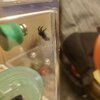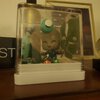SongbirdAndDude
Arachnopeon
- Joined
- Mar 28, 2024
- Messages
- 1
It is actually my husband's pet but I'm helping out. So pardon me if I don't use all the correct terms. This is a baby bold jumping spider and we think he has plenty of water and such.He currently has 3 webs. Two in the top corners and one behind the leaf. Is there anything we should be concerned about or are we worrying for nothing. We received him Saturday and he had eaten part of the crickets at the expo and Monday we attempted to feed him fruit flies but don't think he ate any (although one dissappeared and we don't know if it was lost in transfer or he ate it). We've given him fruit flies and he seems generally uninterested. But to me he doesn't look full. We attempted to give him a new cricket but he attacked it once then backed away. The cricket died in the process of us trying to feed him. So my question is does he look well fed to you? I appreciate any other info too. Like how to feed him fruit flies or things bigger then him, signs to look out for of him being in distress, signs of molting, cautions, how old he looks, etc. What other info can you jumping spider veterans tell me? My husband is more attached to him then he let's on and I want to do my best to help Raf-Wrath, as we call him, live his whole life even though I'm a slight arachnophobe (Don't worry, my husband will do the handling). Thank you
Attachments
-
334.6 KB Views: 14
-
20.3 MB Views: 2
-
374.4 KB Views: 14
-
358.6 KB Views: 14




